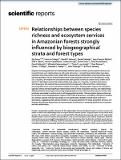Por favor, use este identificador para citar o enlazar a este item:
http://hdl.handle.net/10261/267314COMPARTIR / EXPORTAR:
 SHARE SHARE
 CORE
BASE CORE
BASE
|
|
| Visualizar otros formatos: MARC | Dublin Core | RDF | ORE | MODS | METS | DIDL | DATACITE | |

| Título: | Relationships between species richness and ecosystem services inAmazonian forests strongly infuenced by biogeographical strata and forest types |
Autor: | Steur, Gijs; Steege, Hans ter; Verburg, René W.; Sabatier, Daniel; Molino, Jean-François; Bánki, Olaf S.; Castellanos, Hernan; Stropp, Juliana CSIC ORCID; Fonty, Émile; Ruysschaert, Sofie; Galbraith, David; Kalamandeen, Michelle; Andel, Tinde R. van; Brienen, Roel; Phillips, Olivier L.; Feeley, Kenneth; Terborgh, John; Verweij, Pita A. | Fecha de publicación: | 8-abr-2022 | Editor: | Nature Publishing Group | Citación: | Scientific Reports 12: 5960 (2022) | Resumen: | Despite increasing attention for relationships between species richness and ecosystem services, for tropical forests such relationships are still under discussion. Contradicting relationships have been reported concerning carbon stock, while little is known about relationships concerning timber stock and the abundance of non-timber forest product producing plant species (NTFP abundance). Using 151 1-ha plots, we related tree and arborescent palm species richness to carbon stock, timber stock and NTFP abundance across the Guiana Shield, and using 283 1-ha plots, to carbon stock across all of Amazonia. We analysed how environmental heterogeneity influenced these relationships, assessing differences across and within multiple forest types, biogeographic regions and subregions. Species richness showed significant relationships with all three ecosystem services, but relationships differed between forest types and among biogeographical strata. We found that species richness was positively associated to carbon stock in all biogeographical strata. This association became obscured by variation across biogeographical regions at the scale of Amazonia, resembling a Simpson’s paradox. By contrast, species richness was weakly or not significantly related to timber stock and NTFP abundance, suggesting that species richness is not a good predictor for these ecosystem services. Our findings illustrate the importance of environmental stratification in analysing biodiversity-ecosystem services relationships. | Versión del editor: | https://www.nature.com/articles/s41598-022-09786-6 | URI: | http://hdl.handle.net/10261/267314 | DOI: | 10.1038/s41598-022-09786-6 | ISSN: | 2045-2322 |
| Aparece en las colecciones: | (MNCN) Artículos |
Ficheros en este ítem:
| Fichero | Descripción | Tamaño | Formato | |
|---|---|---|---|---|
| Stropp_J_Relationships.pdf | Artículo principal | 1,59 MB | Adobe PDF |  Visualizar/Abrir |
CORE Recommender
SCOPUSTM
Citations
1
checked on 21-abr-2024
WEB OF SCIENCETM
Citations
1
checked on 19-feb-2024
Page view(s)
35
checked on 12-may-2024
Download(s)
29
checked on 12-may-2024
Google ScholarTM
Check
Altmetric
Altmetric
NOTA: Los ítems de Digital.CSIC están protegidos por copyright, con todos los derechos reservados, a menos que se indique lo contrario.
